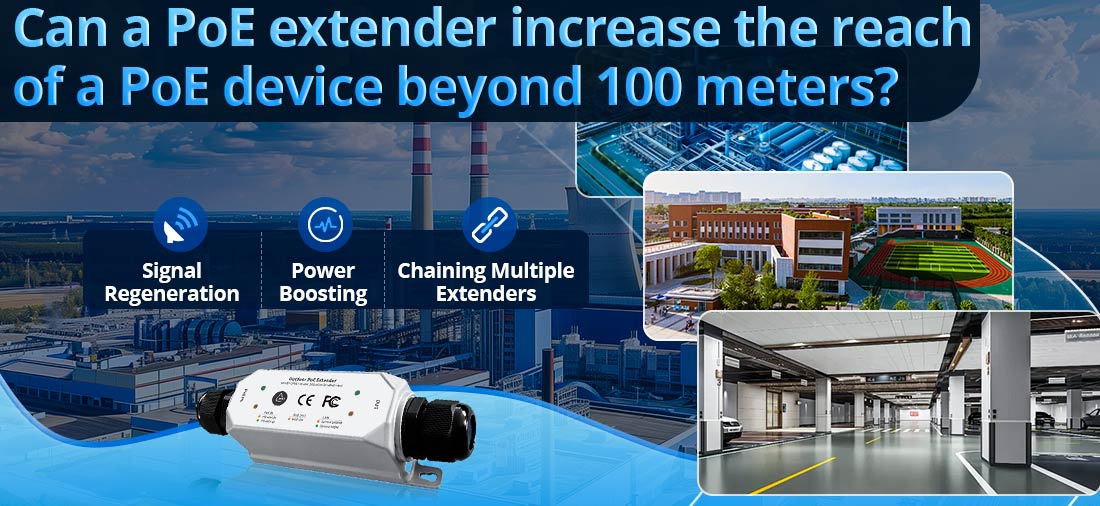
Может ли удлинитель PoE увеличить радиус действия устройства PoE за пределы 100 метров?
Да, удлинитель PoE специально разработан для увеличения радиуса действия устройства Power over Ethernet (PoE) сверх стандартного ограничения на длину кабеля Ethernet в 100 метров (328 футов). Это достигается за счет регенерации сигналов питания и данных, что обеспечивает бесперебойную работу на больших расстояниях.
Как работает удлинитель PoE
1. Регенерация сигнала
--- Сигналы Ethernet естественным образом ухудшаются на больших расстояниях. А PoE-удлинитель принимает входящий сигнал данных, усиливает или регенерирует его и пересылает на подключенное устройство PoE. Это обеспечивает стабильное и надежное соединение.
2. Повышение мощности
--- Удлинитель также получает питание от источника PoE (например, коммутатора или инжектора PoE) и перераспределяет его на нижестоящее устройство. Он поддерживает необходимые уровни напряжения и тока для правильной работы устройства.
3. Объединение нескольких расширителей
--- В некоторых случаях несколько удлинителей PoE могут быть подключены последовательно для достижения еще больших расстояний. Каждый удлинитель добавляет дополнительные 100 метров в зависимости от модели и бюджета мощности.
Возможности PoE-удлинителя
Расширение расстояния
--- Один удлинитель PoE обычно добавляет 100 метров дальности действия. Путем каскадного подключения нескольких расширителей общее расстояние можно увеличить до 300 метров и более, в зависимости от конкретных требований сети и бюджета мощности.
Дополнительный источник питания не требуется
--- Большинство удлинителей PoE получают питание от существующей сети PoE, поэтому им не требуется отдельная розетка на месте установки.
Совместимость
--- Расширители PoE поддерживают стандартные протоколы PoE, такие как IEEE 802.3af (PoE), 802.3at (PoE+), а некоторые поддерживают 802.3bt (PoE++), что делает их подходящими для устройств с различными потребностями в электропитании.
Приложения
1. Системы IP-наблюдения
--- Удлинители позволяют устанавливать камеры с поддержкой PoE в удаленных или открытых местах вдали от основного сетевого коммутатора или источника питания.
2. Точки беспроводного доступа
--- Они позволяют развертывать точки доступа в больших зданиях, кампусах или на открытых площадках, длина кабеля которых превышает 100-метровый предел.
3. Системы умного строительства
--- Датчикам, домофонам и системам контроля доступа в больших зданиях часто требуются удлинители PoE для доступа к удаленным местам.
Ключевые соображения
1. Бюджет мощности
--- Доступная мощность уменьшается с каждым повторителем из-за потери мощности в кабеле Ethernet и самом расширителе. Убедитесь, что общая мощность, обеспечиваемая источником PoE, может поддерживать расширитель и нижестоящее устройство.
2. Пропускная способность данных
--- Хотя расширители регенерируют сигналы данных, они не увеличивают пропускную способность сети. Приложения с высокой пропускной способностью могут потребовать тщательного планирования, чтобы избежать задержек.
3. Качество кабелей
--- Используйте высококачественные кабели Ethernet (например, Cat 5e или Cat 6), чтобы минимизировать потери сигнала и обеспечить оптимальную производительность.
4. Максимальное каскадирование
--- Существует практическое ограничение на количество каскадируемых расширителей. За пределами 3-4 расширителей целостность сигнала и мощности может значительно ухудшиться.
Преимущества удлинителей PoE
--- Расширьте мощность и данные без дополнительной инфраструктуры.
--- Простая установка «подключи и работай».
--- Экономичность по сравнению с развертыванием дополнительных коммутаторов или локальных источников питания.
--- Компактный дизайн для удобного размещения в труднодоступных или отдаленных местах.
Заключение
Удлинитель PoE эффективно увеличивает дальность действия устройства PoE за пределы стандартного ограничения кабеля Ethernet в 100 метров. Это надежное и экономичное решение для приложений, требующих устройств с поддержкой PoE в удаленных местах. Обеспечивая правильное планирование бюджета мощности, качества кабеля и пропускной способности данных, вы можете добиться стабильного и расширенного подключения для различных вариантов использования, таких как наблюдение, беспроводные сети и системы «умных зданий».